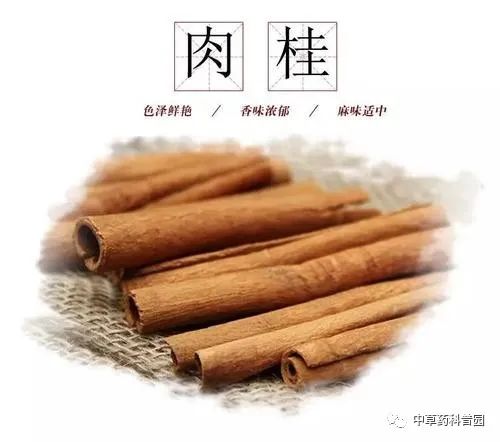 Cinnamon Encyclopedia
Cinnamon Encyclopedia
【Source】 Dried bark of the Cinnamomum plant.
【Related Names】 Chinese cinnamon, cassia, bay cinnamon, and fungus cinnamon.
【Taste and PropertiesMeridians】 Pungent, sweet, and warm. Enters the Kidney, Spleen, Heart, and Liver meridians.。
【Functions】 Tonifies Yang, returns fire to the source, disperses cold and alleviates pain, warms and unblocks the meridians.
【Characteristics】 Pungent and sweet, warm and purely Yang. Enters the Kidney meridian, effectively warming and tonifying the fire of the Mingmen (Gate of Life), benefiting Yang, dispelling Yin, and returning fire to the source, making it a key herb for treating coldness and Yang deficiency. Enters the Spleen meridian, effectively warming Spleen Yang and dispersing cold pathogens, making it an excellent choice for treating Yang deficiency with internal cold. Enters the Heart and Liver meridians, effectively dispersing Yin cold in the blood and warming the meridians to unblock the channels, commonly used for treating blood stasis due to cold.
【IndicationsConditions】 Used for impotence due to cold in the uterus, cold pain in the lower back and knees, cough due to Kidney deficiency, floating Yang, dizziness, red eyes, cold pain in the heart and abdomen, cold vomiting and diarrhea, cold hernia abdominal pain, and dysmenorrhea.
【Dosage and Administration】 Take 1-2 grams in powder form; decoct 2-5 grams.
【Precautions】 This herb is pungent and warm, promoting fire and moving blood, thus contraindicated for pregnant women and those with excess heat or blood heat. Not suitable for those with Yin deficiency and excess heat. Avoid with red stone fat.
【Origin】 Mainly produced in Guangxi, Guangdong, and other provinces, also found in Yunnan and Fujian. Mostly cultivated.
【Harvesting and Processing】 Harvested in two periods each year, the first from April to May, and the second from September to October, with the second period yielding larger quantities, stronger aroma, and better quality. During harvesting, select mature cinnamon trees, strip the bark to a certain length and width, place it in a cool place, trim to various specifications, or press into shape using wooden “cinnamon clamps,” then air dry or first place in a cool area for 2-3 days before drying in weak light.

【Modern Pharmacological Research】
Cinnamon contains about 2% volatile oil, with a maximum of 5.86%. The main components of the oil include cinnamaldehyde, cinnamic acid, benzyl acetate, cinnamyl acetate, cinnamyl alcohol, and coumarin. Additionally, it contains choline, β-sitosterol, protocatechuic acid, tannins, water celery, and eugenol. Cinnamon can adjust the body’s material energy metabolism by regulating neurohumoral factors, improving the body’s stress response, and restoring physiological balance. This herb has cardiotonic, vasodilatory, anti-thrombotic, anti-hypoxic, antioxidant, sexual function improving, adrenal cortex protective, anti-ulcer, choleretic, analgesic, sedative, antipyretic, anti-inflammatory, and antibacterial effects.
Famous Doctors’ Tips
Li Ruilan (Chief Physician, Inner Mongolia Zhongmeng Hospital)
Cinnamon is a key herb for the Liver and Kidney, tonifying the fire of the Mingmen. It treats stubborn cold and deep-seated cold, and for eye diseases, it can be used boldly in cases where there is a systemic Yang deficiency and cold, without being restricted to the eye disease lacking deficiency and cold symptoms, and should not be used with overly hot herbs.
For treating corneal opacity, spots, and vitiligo, use cinnamon with 12 grams each of cicada slough, snake slough, chrysanthemum, red peony, gentian, and 9 grams each of siler and platycodon.
Yao Xixian (Chief Physician, Hebei Medical University)
For significant cold sensation in the upper abdomen, use 15-30 grams of cinnamon, with 6-10 grams of myrobalan fruit, 15 grams each of fried Atractylodes (Bai Zhu) and Poria (Fu Ling), and 6 grams each of amomum and costus.

 Cinnamon Dietary Recipes
Cinnamon Dietary Recipes
1. Lamb Cinnamon Soup:
Add 6 grams of cinnamon to about 1 pound of stewed meat; after cooking, whether eating the meat or drinking the soup, it can warm the middle, strengthen the stomach, warm the lower back and knees, and treat abdominal cold and bloating.
2. Cinnamon Powder:
Grind 3 grams of cinnamon into a fine powder, take twice a day with warm water, can treat stomach bloating and cold pain; adding cinnamon powder to dishes can help control blood sugar and cholesterol.
3. Cinnamon Brown Sugar Tea:
Boil 3-6 grams of cinnamon with 12 grams of brown sugar, strain, and take warm in two doses. Can treat postpartum abdominal pain in women: before menstruation, use 3 grams of cinnamon, 9 grams of hawthorn fruit, and 30 grams of brown sugar, boil with appropriate water for three to five minutes, and take in two doses. Can treat abdominal bloating and pain during menstruation.
4. Cinnamon Paste:
Grind 6 grams of cinnamon and 6 grams of clove into a fine powder, mix into a plaster, and apply to the navel of children to treat diarrhea.
5. Cinnamon Aconite Egg Soup:
Use 3 grams of cinnamon, 9 grams of aconite, and 1 egg; boil the cinnamon and aconite, strain, then add the egg, cook, and consume the egg and drink the broth twice a day. Can treat excessive vaginal discharge.
Take two spoons of honey and one spoon of cinnamon powder mixed in a cup of hot water 30 minutes before breakfast and before bed. Regular consumption can prevent fat accumulation even when consuming high-calorie foods.

 A Little Story About Cinnamon
A Little Story About Cinnamon
Once upon a time, in Wangjiawan at the foot of Sifang Mountain, there was a landlord named Wang who controlled the surrounding area. Sifang Mountain was high and dense with forests, home to many precious medicinal materials and wild animals. The landlord posted a notice that Sifang Mountain was bought with ten thousand taels of gold by his ancestors, and no one was allowed to enter without permission.
One year, due to drought, the crops had no water for irrigation, and the farmers suffered a total loss. Daily drinking water became a big problem for the common people, who had to fetch water from the Yangtze River 15 miles away. The landlord had a daughter, 16 years old, who suffered from a strange illness, having days each month when her complexion turned pale and her stomach hurt severely. The landlord invited shamans to perform rituals, but nothing could solve the problem. So the landlord went into the mountains to pray for the gods, hoping to bless his daughter to be free from illness.
One day, while the landlord was burning incense and praying in the mountains, a young man suddenly approached. The mountain protection team captured the young man and said, “You bold peasant, how dare you come to my lord’s land with a basket looking for food? Don’t you fear us breaking your legs?” The young man laughed and said, “Of course, I fear my lord breaking my legs! However, last night, the Medicine King Bodhisattva appeared in my dream and said that the young lady is suffering from a strange illness, but out of respect for your lord’s sincerity, he sent me to tell you that there is a herb in this mountain that can cure the young lady’s illness. However, there is a condition: if I cure the young lady’s illness, you must lift the ban and allow the nearby common people to enter the mountain to dig wild vegetables and drink well water.”
The landlord, who had always respected the gods, asked the young man what the Medicine King Bodhisattva said. The young man replied, “At the top of Sifang Mountain, there is a patch of grass, and in that grass, there is a deer guarding a well. The Medicine King Bodhisattva said that the first water from this well must be drunk by the young lady, and after drinking, a channel must be dug to allow the people below the mountain to drink, which will alleviate half of the young lady’s suffering. Additionally, there is a tree in the mountain that emits fragrance from its branches to its leaves; the bark of this tree should be boiled in well water or ground into powder for the young lady to drink, and her illness will be cured.” The landlord, half-believing, decided to go up the mountain with the young man. Upon reaching the top, they indeed saw a lush patch of grass with a deer, and they quickly dug a well, from which clear spring water gushed forth. The landlord hurriedly scooped some to taste; the spring water was refreshing, so he ordered his men to continue digging, allowing the spring water to flow down the mountain. Then, the young man called the common people from below the mountain to come up to dig wild vegetables, helped cut the bark of the fragrant camphor tree, and used some of the bark to boil water for the young lady to drink, while drying and grinding some of the bark into powder for her to swallow. Before long, the young lady’s illness was cured. The landlord kept his promise and allowed the nearby common people to enter the mountain to dig wild vegetables and drink well water. The people named that well “Deer Well,” and the bark used to cure the young lady’s illness was called “Cinnamon.”

